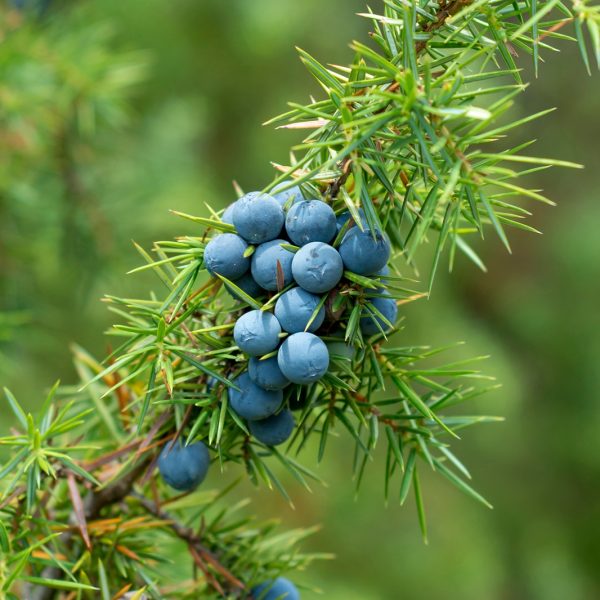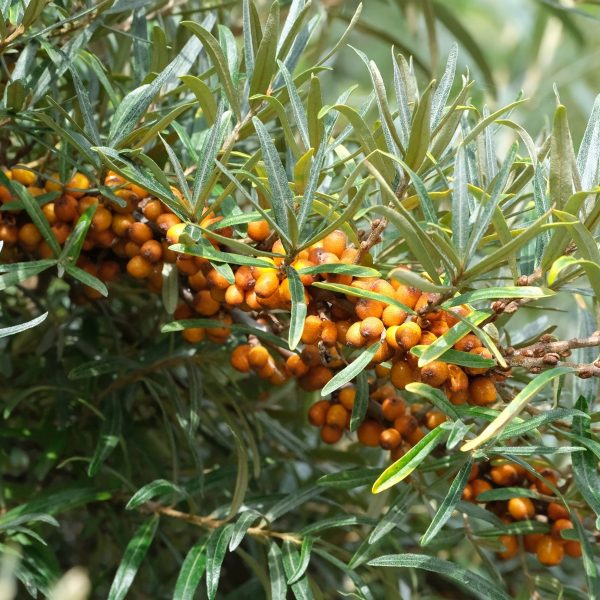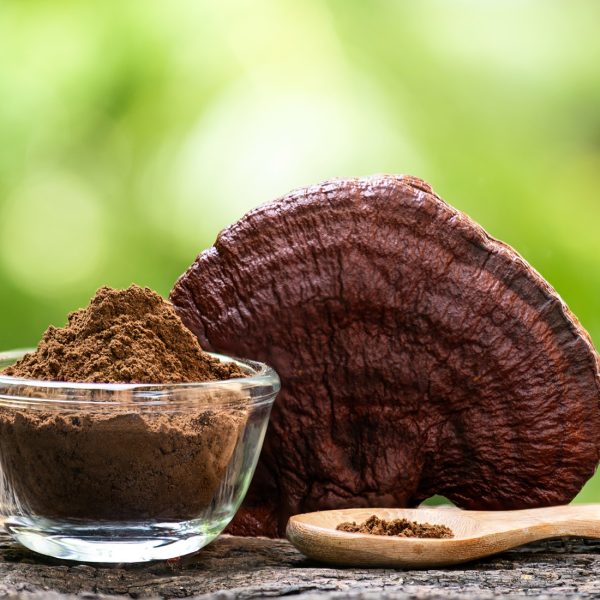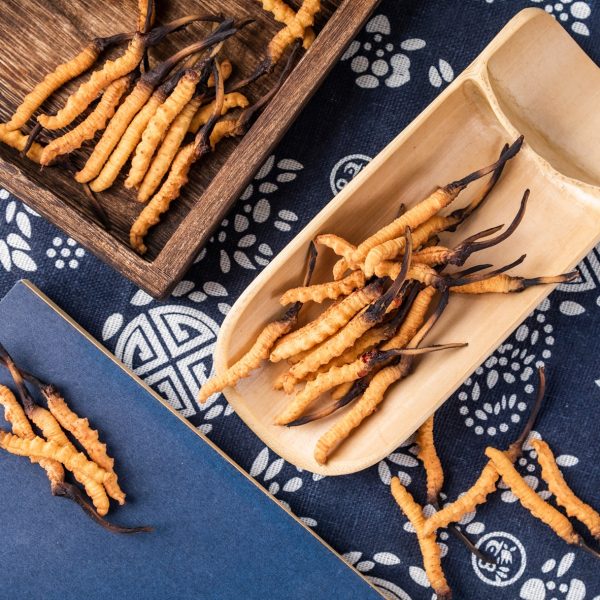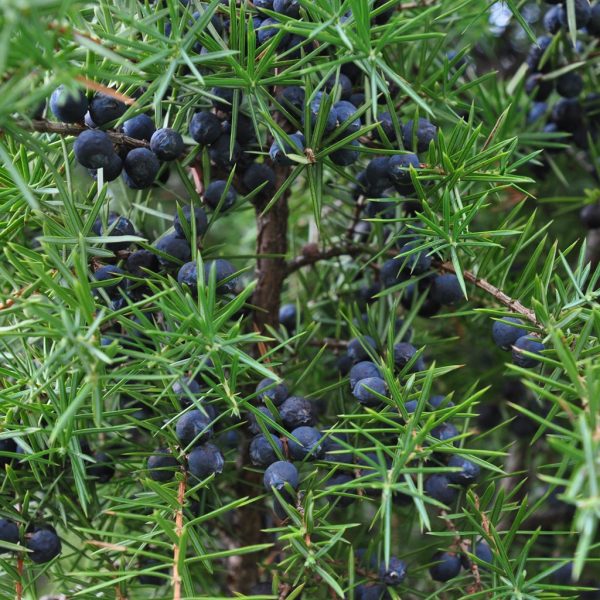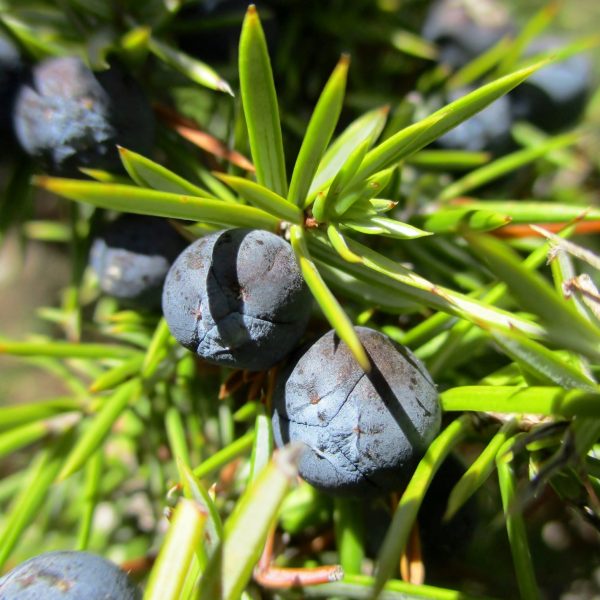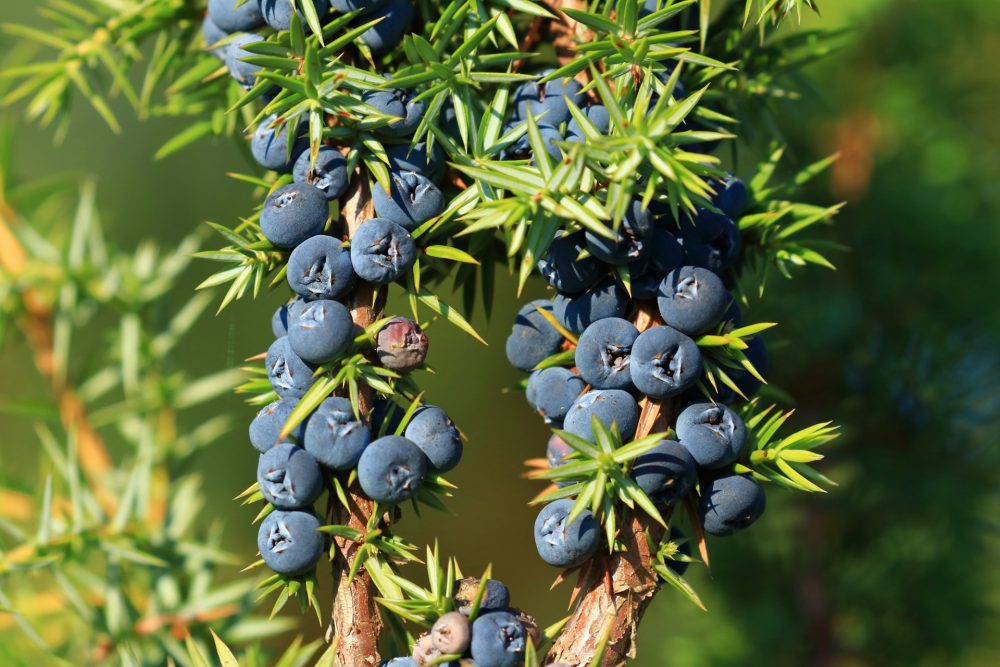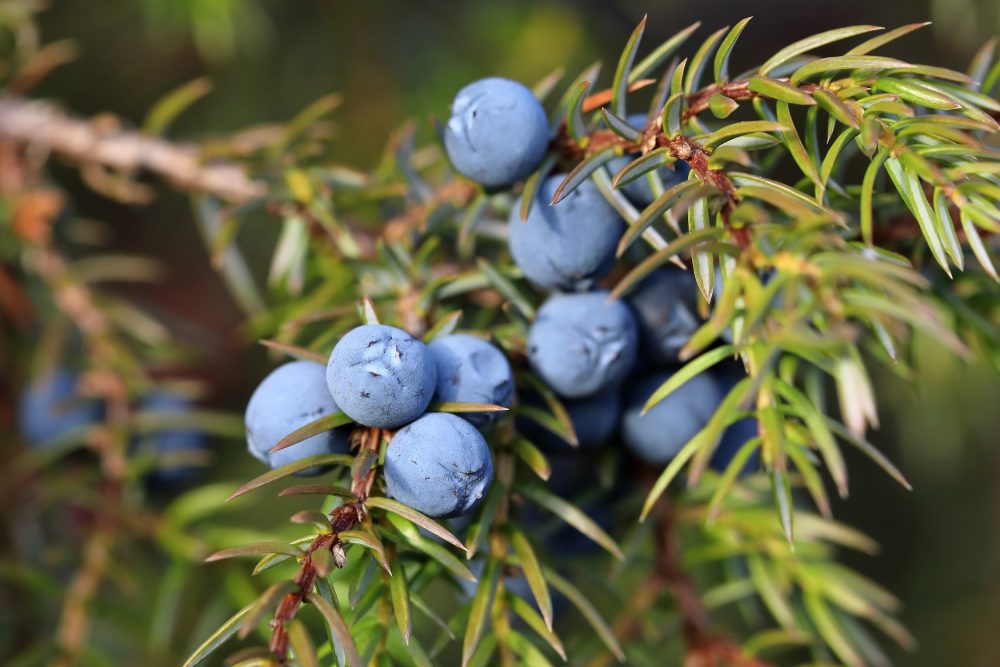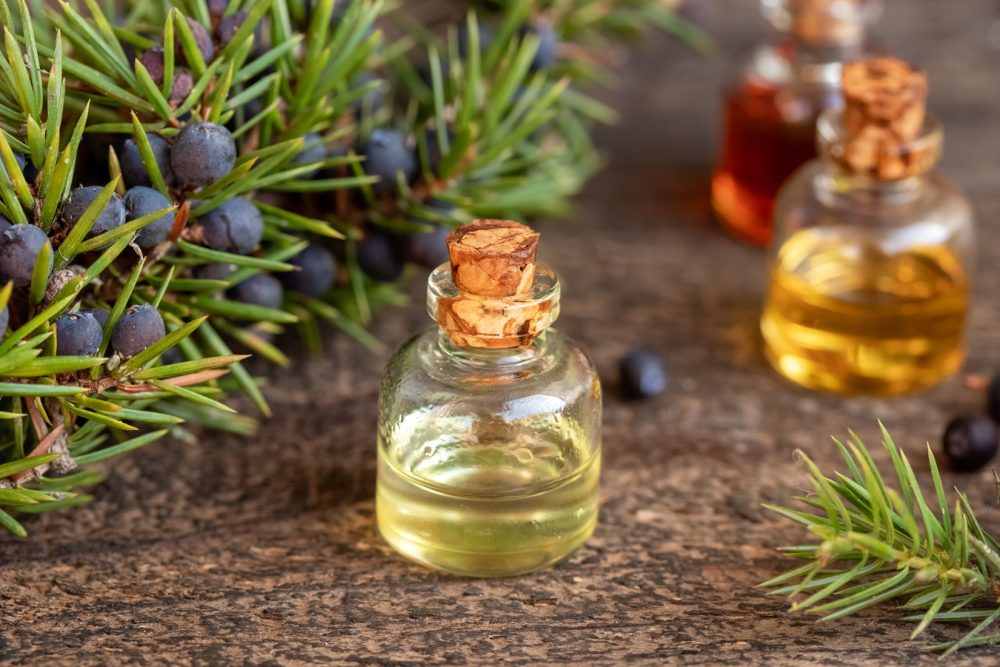-
How does it feel?
A tincture of the dried berries of juniper (Juniperus communis) diluted in water has a distinct but mild bitterness, feels drying on the tongue and leaves a warm, pine-like and lightly resinous taste in the mouth (1,2). The aroma of the tincture, whilst aromatic, is not as strong or complex as the berry’s essential oil. The scent of the essential oil has fresh, balsamic, pine-like, and eucalyptus notes, followed by more peppery, slightly sweet and almost floral mid and base notes.
The feeling provoked by inhaling or drinking extracts of juniper is one of calm alertness, and an energising, stimulating and mind-clearing sensation. This is interesting given the essential oil’s indications for countering a loss of motivation, apathy and low self-esteem (3).Juniper contains up to ~2% essential oil, of which the three primary chemical constituents are 𝝰-pinene (up to ~55.4%), Sabinene (up to ~28.8%) and 𝝱-Myrcene (up to ~22%), which are monoterpenes and are responsible for the fresh, clarifying, stimulating properties and aromas (4–6).
Energetically, juniper is considered a yang stimulant in traditional Chinese medicine (TCM), and as such is used for treating cold or damp conditions (7). This warming action is again reflected in its motivating, uplifting and energising effects on the body and mind.
-
What can I use it for?

Juniper (Juniperus communis) Juniper berry is used (diluted to around 2%) in its essential oil form as an external treatment for hair growth or psoriasis (1,4,8). This is due to its rubifacient properties; it is useful for warming the skin and supporting elimination of waste metabolites in the surrounding tissues (10).
For neurological and psychospiritual conditions, juniper is best used as an essential oil externally in a massage oil or liniment, or via inhalation (6,9). This is because inhaling essential oil is the quickest route to the brain, and can create an almost immediate effect on mood or mindset (10). Conditions or states of mind that can benefit from treatment with juniper essential oil include ADHD, depression, low confidence, negative thoughts or unhelpful habits and psychological stagnation in general (3,7,9).
Internally, the tincture or an infusion of the berries can be used to treat a range of conditions, including joint and muscular aches and pains (including arthritis), urinary infection or retention, digestive complaints like indigestion or abdominal pain, and dysmenorrhoea (period pain) (1,3,8).
-
Into the heart of juniper

Juniper (Juniperus communis) Juniper is a herb with a wide range of actions — including digestive and reproductive actions — but its main affinity is for the musculoskeletal and urinary systems. Disorders of these two systems can co-occur, especially in older age, so with its gently stimulating and cleansing in nature, juniper is particularly supportive in cases where there are overlaps between muscular or articular aches and pains, difficulty or painful urination, water retention and/or bloating (3,11).
It is considered a warming herb, stimulating both the circulation and appetite (7). It is also a urinary tonic, and is both strongly antiseptic and diuretic, so is also very helpful in conditions like cystitis and gout, although should be avoided where there is kidney damage or infection (8)
Its tonic and eliminatory actions extend to psychological and energetic actions too; being stimulating and energising for the mind, and considered purifying, too — hence its use for treating low motivation or in cases where there is general psychological stagnation (3,7). Said to strengthen the will or zhi in traditional Chinese medicine (TCM), which is connected to the water element and in turn governs emotions and states of being like fear and courage (3,9). From this TCM understanding of juniper, we can more clearly see why and how it is understood to have purifying qualities for the mind, strengthening our confidence, self worth and releasing negative thoughts or fears (7,12).
-
Traditional uses
Culpeper, the famous English 17th-century physician and herbalist said that juniper “strengthens the brain” and “the nerves” — echoing the TCM perspective on juniper (13). Amongst Culpeper’s recommendations for the medicinal use of juniper are many of the modern applications, but he also recommended it for treating conditions like dropsy (what we now call oedema), the “bites of venomous beasts” and “fits of the mother” — ironic, then, that the 18th-century production boom of gin (which is usually distilled with juniper) would go on to gain notoriety as the “mother’s ruin” (14).
Mrs Grieve, the 20th-century herbalist also cites its use in treatment of “cardiac and hepatic dropsy” and notes that in France, the berries were given for “chest complaints” and in cases of scrofula (lymph node inflammation caused by tuberculosis), leucorrhoea and blenorrhoea (infective discharge) (15).
Furthermore, the 12th Century German healer-herbalist Hildegard von Bingen suggests a sauna with branches of juniper to support the chest, lungs and liver (16).
-
Traditional actions
Herbal actions describe therapeutic changes that occur in the body in response to taking a herb. These actions are used to express how a herb physiologically influences cells, tissues, organs or systems. Clinical observations are traditionally what have defined these actions: an increase in urine output, diuretic; improved wound healing, vulnerary; or a reduction in fever, antipyretic. These descriptors too have become a means to group herbs by their effects on the body — herbs with a nervine action have become the nervines, herbs with a bitter action are the bitters. Recognising herbs as members of these groups provides a preliminary familiarity with their mechanisms from which to then develop an understanding of their affinities and nuance and discern their clinical significance.
Western actions
Ayurvedic actions
-
Traditional energetic actions
Herbal energetics are the descriptions Herbalists have given to plants, mushrooms, lichens, foods, and some minerals based on the direct experience of how they taste, feel, and work in the body. All traditional health systems use these principles to explain how the environment we live in and absorb, impacts our health. Find out more about traditional energetic actions in our article “An introduction to herbal energetics“.
Western energetics
Chinese energetics
-
What practitioners say
 Musculoskeletal system
Musculoskeletal systemInternally, juniper is an effective eliminator of uric acid, the build up of which is a contributing factor in gout (1,17). It works by breaking down and eliminating crystal build up and formation by way of synergy of the anti-inflammatory effects of the flavonoids it contains alongside the diuretic effect of its essential oil compounds (which includes α-pinene, terpinen-4-ol and thujone) (1). It may be prescribed alongside herbs like nettle leaf or celery seed, due to the antispasmodic properties of its volatile oil constituent, apiol.
Its circulatory stimulant actions alongside its ability to reduce cholesterol aid its distribution to the site of inflammation, and it is particularly suited to those prone to conditions associated with cold, damp or stagnation — including rheumatic conditions like arthritis or gout (16).
Juniper can also relieve musculoskeletal pain and inflammation topically, also through its anti-inflammatory properties, which are again primarily attributed to its volatile oils and flavonoids, since they inhibit COX-2 enzymes (which decreases prostaglandin synthesis thus reducing pain) and reduce pro-inflammatory cytokines (18,19).
Urinary system
Juniper’s essential oil constituents 𝝰- and 𝛃-pinene as well as 𝗽-cymene are understood to be responsible for the herb’s urinary antimicrobial properties, whereas its diuretic properties are largely attributed to terpinen-4-ol; there are limited studies in humans on these effects, however, most of the research being on animal models (1). It may be combined with urinary demulcent herbs such as corn silk and nourishing, remineralising herbs like nettle leaf to treat urinary tract infections or inflammation.
Nervous system
Inhalation of juniper berry essential oil is the most effective application method for emotional and psychological conditions (10) and can be combined with other warming, clarifying oils in a diffuser or massage blend to aid its effect: For example, essential oils of lemon or grapefruit pair well with juniper due to their energetically “moving” and dispersing qualities (9,20).
Digestive system
As a carminative herb, juniper can be useful in the treatment of disrupted digestion, pain and flatulence, even being used to treat food poisoning — echoing its historical use as a “counter poison” (13,21).
Skin health
Juniper’s high percentage of monoterpenes (volatile compounds) make it astringent in addition to being antiseptic, and therefore it can be used as part of a skincare treatment for excess oil or congested skin (22).
Reproductive system
Due to their warming, stimulant and circulatory activity, juniper berries (or their essential oil) can be infused into a base oil to make a circulatory stimulant topical massage oil — especially useful in the treatment of dysmenorrhoea (period pain) (21).
-
Research

Juniper tincture (Juniperus communis) Efficacy and safety of abhal (Juniperus communis L). on pain intensity, uterine artery doppler flow, and quality of life in primary dysmenorrhea: A double-blind, randomized controlled trial
A 2025 study to assess the efficacy and safety of juniper berry (compared to mefenamic acid) for the treatment of menstrual cramps and co-occurring symptoms was conducted with 62 participants aged 18–35 years who experienced primary dysmenorrhea. It also assessed the impact of both interventions on uterine blood flow. Participants were randomly prescribed either 750 mg of juniper berry or 250 mg of mefenamic acid three times per day.
After the interventions, both juniper and control groups showed significant reduction in mean pain intensity scores, and juniper demonstrated “significant efficacy and safety in reducing menstrual cramps…associated symptoms and improving health-related quality of life” (23). The small study size indicates that larger high-quality studies are needed to confirm these findings.
Evaluation of anticancer effects of Juniperus communis extract on hepatocellular carcinoma cells in vitro and in vivo
A 2021 in vitro and animal study conducted using juniper essential oil (steam distilled) investigated the impact of the oil on human hepatocellular carcinoma cells, and then in mice (injected with hepatocellular carcinoma cells). The study found that the juniper extract “significantly inhibited the growth” of the cancerous cells via antiproliferative effects and subsequent induction of cell apoptosis as well as by preventing cell signalling, with no safety concerns (24). While these results show promise, further research is recommended to test these findings.
Innovative application of Juniperus communis wood oil in acne skincare: Analyzing its antimicrobial properties
A 2024 study reviewed research investigating the use of juniper wood oil in the treatment of acne. It found that juniper wood oil has shown potential in reducing acne lesions, irritation, and sebum production through mechanisms including its inhibitory effects on inflammatory processes, oxidation, and sebum secretion — along with antimicrobial activity (25). Robust randomised clinical trials would be needed to support these findings.
-
Did you know?
Juniper is sometimes known as “mountain yew” in Scotland, and historically in the region it was believed to ward off evil spirits (16).
Additional information
-
Botanical description
An evergreen shrub, columnar or bushy in habit, with aromatic, needle-like green leaves and small ovoid green berries that eventually ripen to purplish-black (28).
-
Common names
- Juniper
- Genevre
- Genévrier
- Ginepro
- Enebro
-
Interactions
Taking juniper berry with diabetic medications might cause additive hypoglycemia — this is based on theoretical data only, since animal research shows that taking juniper berry internally can lower blood glucose (26). It is classified as having a moderate, possible interaction (26).
Taking juniper internally alongside lithium may reduce lithium excretion as well as increase serum lithium, due to the diuretic effect of juniper (26). The risk is classified as a minor possible interaction (26).
-
Contraindications
Juniper (topical or inhalation of the essential oil and internal use of tincture or infusion) is contraindicated in pregnancy and lactation since it can stimulate uterine contractions and is potentially emmenagogue (1,4,27). It is also advisable to avoid this herb in cases of heavy menstrual bleeding (8).
It should not be used internally where there is acute or chronic kidney inflammation or infection — it can cause irritation, signs of which include albuminuria and cloudy urine output (4,6). Whilst unlikely that it would be used alone, continually and at its maximum advised dose, it should not be taken internally for longer than six weeks at a time (6,27).Despite these contraindications, several studies show that juniper essential oil is non-toxic, even when given internally at high doses (which is emphatically not advised) (22). Tisserand and Young confirm this assertion, but note that oxidised essential oil may cause skin sensitisation and, as such, should be avoided (5).
-
Preparations
Topical juniper preparations
- Liniment
- Massage oil
Internal juniper preparations
- Essential oil (inhalation)
- Tincture
- Infusion
-
Dosage
- Tincture (1:5 | 45%): 1–2 ml three times daily (16) or FE 1:1 | 25% 2–4 ml daily (1)
- Infusion: Up to 1 tsp of crushed berries in a cup of boiling water, infused (covered) for 30 minutes, three times daily (16)
- Liniment: 5% dilution, applied topically to the affected area (3)
- Massage oil: 3–5% dilution in suitable base oil (3)
- Inhalation (diffuser): 2–3 drops in water (3)
-
Plant parts used
- Berries (the part majoritively used — picked when matured to three years, when dark purple-black) (16)
- Leaves (less commonly — used in infusions, or distilled into essential oil) (16)
- Bark (less commonly)
- Heartwood (less commonly)
- Roots (less commonly — externally for treating skin infections) (16)
-
Constituents
Constituents for juniper berries (1,5)
- Essential oils (<3.4%): Terpinen-4-ol (1.5–17%), (+)-limonene (<10.9%), 𝛃-pinene (2.1–6%), 𝜸-terpinene (<5.8%)
- Flavonoids
- Resins (<10%)
- Bitter glycoside: Juniperin
- Tannins (condensed)
- Vitamin C
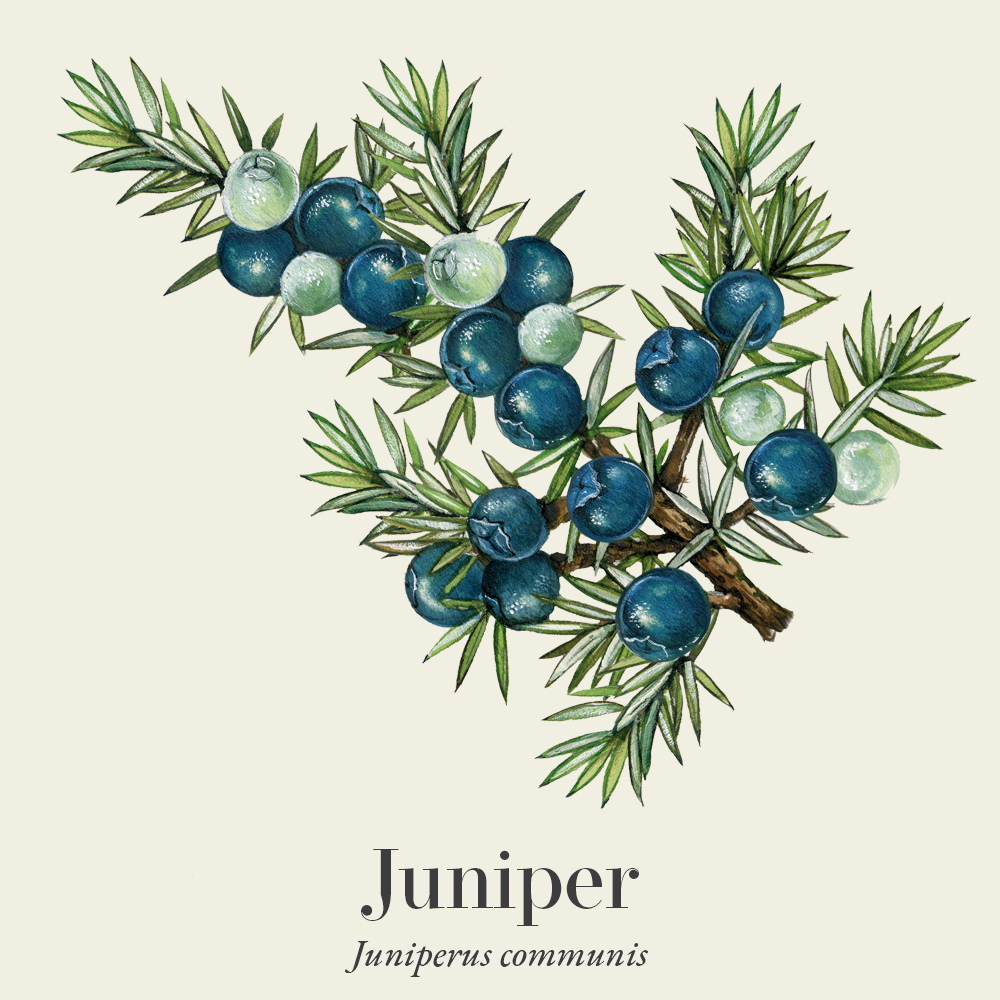
-
Habitat
Its native range spans much of the northern hemisphere, including North America, Greenland, Europe, the Middle East, and Asia (2). It will grow in full sun or partial shade, in either sheltered or exposed conditions, preferring moist but well-drained soils – these can be acidic, alkaline or neutral in pH (28).
-
Sustainability

Critically endangered in the wild. Listed on CITES or National Red Lists. Read more about our sustainability guide. Whilst currently rated as LC (least concern) by the IUCN redlist of threatened species, juniper’s last assessment was in 2011 and as such it is due to be re-evaluated (29). A more recent (2018) evaluation by NatureServe Explorer cites that it is critically endangered, imperiled or vulnerable in some states in the USA (30).
Furthermore, the shrub is in serious decline in the UK in both range and abundance, according to the Woodland Trust (31). It is understood that juniper is unable to regenerate well, due to consumption of its foliage by animals, conditions like Phytophthora root rot and Phytophthora austrocedrae, a fungus-like organism that infects via roots and causes foliage to die (31).
Demand for juniper from the UK gin industry is a consideration, since it puts pressure on UK populations of plants but since the UK decline in juniper has accelerated, many companies now source berries from overseas (32).
Organisations like Plantlife are leading campaigns repopulating juniper in the UK, but herbalists and aromatherapists should research their sources carefully before purchasing juniper products to ensure sustainable harvesting methods (33).
Habitat loss and over-harvesting from the wild are two of the biggest threats faced by medicinal plant species. There are an increasing number of well-known herbal medicines at risk of extinction. We must, therefore, ensure that we source our medicines with sustainability in mind.
The herb supplement industry is growing at a rapid rate and until recent years a vast majority of medicinal plant produce in global trade was of unknown origin. There are some very real and urgent issues surrounding sustainability in the herb industry. These include environmental factors that affect the medicinal viability of herbs, the safety of the habitats that they are taken from, as well as the welfare of workers in the trade.
The botanical supply chain efforts for improved visibility (transparency and traceability) into verifiably sustainable production sites around the world is now certificated through the emergence of credible international voluntary sustainability standards (VSS).
Read our article on Herbal quality & safety: What to know before you buy and Sustainable sourcing of herbs to learn more about what to look for and questions to ask suppliers about sustainability.
-
Quality control
Herbal medicines are often very safe to take; however, their safety and efficacy can be jeopardised by quality issues. So, it is important to buy herbal medicines from a reputable supplier, from sources known to test their herbs to ensure there is no contamination, adulteration or substitution with incorrect plant matter, as well as ensuring that recognised marker compounds are at appropriate levels in the herbs.
Some important quality assurances to look for are certified organic labelling, the correct scientific/botanical name, and the availability of information from the supplier about ingredient origins. A supplier should be able to tell you where the herbs have come from, what contaminants are not in the herb, and what the primary compounds are.
-
How to grow
Juniper can be grown from seed or by cuttings — but seed is preferable to propagation from cuttings, as it will maximise genetic adaptability (34). That said, seed propagation is not easy since germination is slow and/or variable in length, and seeds require cold stratification preceded by a warmer period (34).
-
Recipe

Juniper (Juniperus communis) Juniper joint pain liniment
This joint pain liniment is a liquid product, used topically to treat painful musculoskeletal conditions. It can be used for conditions including muscular, connective tissue and joint issues, headaches and gout.
Ingredients for 100 ml joint pain liniment
- 30 ml St John’s wort (Hypericum perforarum) infused oil
- 30 ml comfrey (Symphytum officinale) (fol) infused oil
- 30 ml chilli (Capsicum annum) tincture
- 10 ml arnica (Arnica montana) infused oil
- 2 ml (50 gtt) rosemary (Salvia rosmarinus)
- 2 ml (50 gtt) juniper (Juniperus communis)
- 2 ml (50 gtt) wintergreen (Gaultheria procumbens)
How to make a juniper joint pain liniment
- Measure out all ingredients and combine.
- Use a small funnel to decant into a 100 ml bottle.
- Use 5 ml 2–3 times per day on the affected area. For topical application only, do not ingest.
- Don’t apply to areas of the skin with eczema or skin irritation — it’s best to do a spot test first (24 hours). Do not use on broken skin.
-
References
- Fisher C. Materia Medica of Western Herbs. Aeon; 2018.
- Royal Botanic Gardens, Kew (RBGK). Juniperus communis L. Plants of the World Online (POWO). . http://powo.science.kew.org/taxon/urn:lsid:ipni.org:names:30088655-2
- Holmes P. Aromatica. Vol 1. Singing Dragon; 2016.
- Caddy R. Essential Oils in Colour. 7th ed. Amberwood Publishing Ltd; 1997.
- Tisserand R, Young R. Essential Oil Safety. 2nd ed. Churchill Livingstone Elsevier; 2014.
- Holmes P. The Energetics of Western Herbs: Treatment Strategies Integrating Western & Oriental Herbal Medicine. Snow Lotus Press; 1997.
- Battaglia S. The Complete Guide to Aromatherapy: Psyche & Subtle. Vol 3. 3rd ed. Black Pepper Creative; 2021.
- Chevallier A. Encyclopedia of Herbal Medicine. 3rd ed. Dorling Kindersley; 2016.
- Mojay G. Aromatherapy for Healing the Spirit: A Guide to Restoring Emotional and Mental Balance through Essential Oils. Gaia Books Limited; 1999.
- Rowland E. The Healing Power of Scent. David and Charles; 2024.
- Senders A, Bauer SR, Chen Y, et al. Lower urinary tract symptoms are associated with musculoskeletal pain among older men: Preliminary evidence for central sensitization as a mechanism? Neurourol Urodyn. 2021;40(8):1929-1938. https://doi.org/10.1002/nau.24767
- The Water element in TCM: tradition, health, and natural balance. Insight Timer Blog. February 5, 2020. . https://insighttimer.com/blog/water-element-tcm/
- Culpeper N. Culpeper’s Complete Herbal. W. Foulsham & Co. Ltd.; 1975.
- History of gin (1728 – 1794). . https://www.diffordsguide.com/g/1108/gin/history-of-gin-1728-1794?utm_source=chatgpt.com
- A Modern Herbal. . https://www.botanical.com/botanical/mgmh/j/junipe11.html
- Stapley C. The Tree Dispensary. Aeon; 2021.
- Gout. nhs.uk. October 18, 2017. . https://www.nhs.uk/conditions/gout/
- Bakó E, Fehérvári P, Garami A, et al. Efficacy of topical essential oils in musculoskeletal disorders: systematic review and meta-analysis of randomized controlled trials. Pharmaceuticals. 2023;16(2):144. https://doi.org/10.3390/ph16020144
- Williams K. Aromahead. Muscle & joint relief: Juniper berry essential oil. November 10, 2024. https://aromahead.com/blog/muscle-joint-relief-juniper-berry-essential-oil
- Rowland E. Healing muscles and joints with essential oils: Recipes from an aromatherapist. Herbal Reality. August 9, 2022. . https://www.herbalreality.com/health-lifestyle/mobility-fitness/healing-muscles-joints-essential-oils-recipes/
- Chown V, Walker K. The Handmade Apothecary: Healing Herbal Remedies. Kyle Books; 2017.
- Martin I. Aromatherapy for Massage Practitioners. Lippincott Williams & Wilkins; 2007.
- Banu T, Sultana A, Begum A, Sidra null, Rahman K. Efficacy and safety of abhal (Juniperus communis L). on pain intensity, uterine artery doppler flow, and quality of life in primary dysmenorrhea: A double-blind, randomized controlled trial. J Ethnopharmacol. 2025;342:119388. https://doi.org/10.1016/j.jep.2025.119388
- Huang NC, Huang RL, Huang XF, et al. Evaluation of anticancer effects of Juniperus communis extract on hepatocellular carcinoma cells in vitro and in vivo. Biosci Rep. 2021;41(7):BSR20211143. https://doi.org/10.1042/BSR20211143
- Ekakitie E. Innovative application of Juniperus communis wood oil in acne skincare: analyzing its antimicrobial properties. J Knowl Learn Sci Technol ISSN 2959-6386 Online. 2024;3(2):253-262. https://doi.org/10.60087/jklst.vol3.n2.p262
- NatMed Pro – Interactions Checker Tool. https://naturalmedicines.therapeuticresearch.com/Tools/InteractionChecker
- Thomsen M. The Phytotherapy Desk Reference. 6th ed. Aeon; 2022.
- Juniperus communis. . https://www.rhs.org.uk/plants/9557/juniperus-communis/details
- IUCN Red List of Threatened Species (IUCN). IUCN Red List of Threatened Species: Juniperus communis. IUCN Red List Threat Species. Published online January 25, 2011. . https://www.iucnredlist.org/en
- NatureServe Explorer. Juniperus communis. NatureServe Explorer. . https://explorer.natureserve.org/Taxon/ELEMENT_GLOBAL.2.1275555/Juniperus_communis
- Woodland Trust. Juniper. Woodland Trust. . https://www.woodlandtrust.org.uk/trees-woods-and-wildlife/british-trees/a-z-of-british-trees/juniper/
- Dhenin M. Gin is an iconic British spirit. What happens when British juniper disappears? Wine Enthusiast. September 24, 2024. . https://www.wineenthusiast.com/culture/british-gin-juniper/
- Saving England’s juniper. Plantlife. . https://www.plantlife.org.uk/our-work/saving-englands-lowland-juniper/
- Broome A. Growing Juniper: Propagation and Establishment Practices. ResearchGate. https://www.researchgate.net/publication/267507172_Growing_Juniper_Propagation_and_Establishment_Practices

